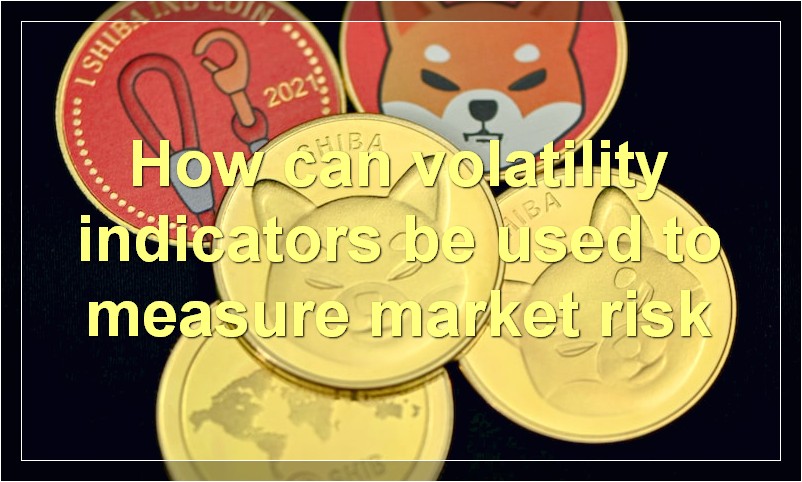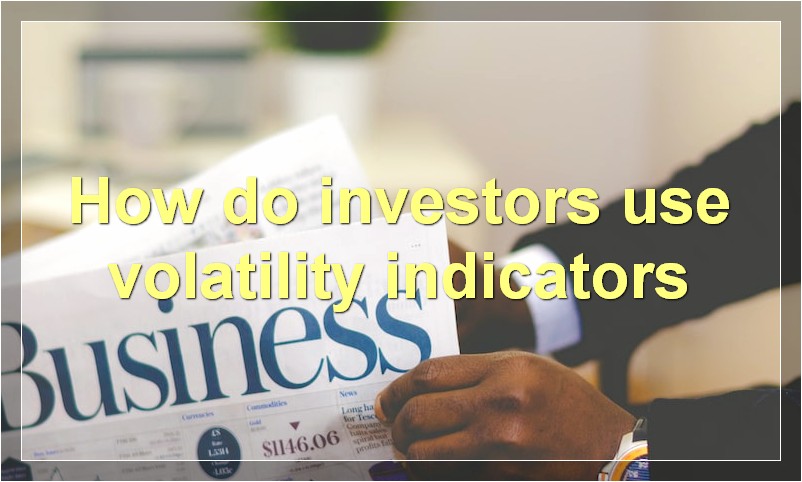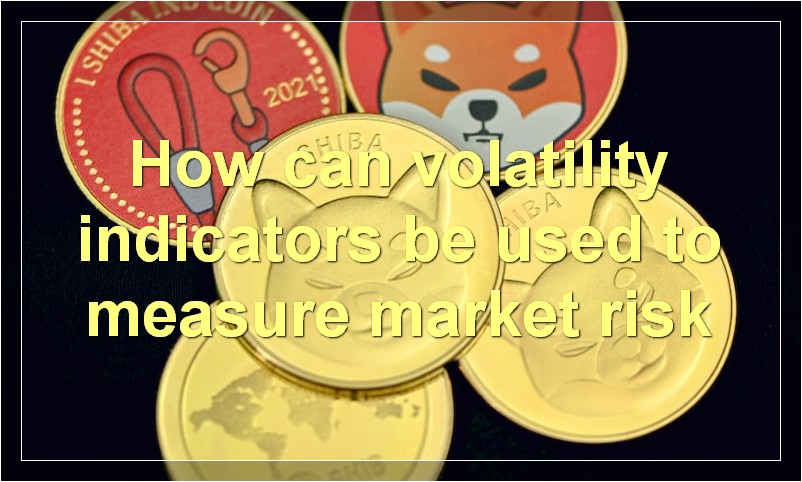If you’re interested in day trading, you need to know about volatility indicators. These technical tools are essential for gauging market conditions and finding profitable trading opportunities. In this article, we’ll explain everything you need to know about volatility indicators.
What are volatility indicators
Volatility indicators are technical indicators that aim to measure the size and scope of price changes. In other words, they tell you how much the price of an asset has moved over a certain period of time.
There are many different volatility indicators, but some of the most popular ones include the CBOE Volatility Index (VIX), the Standard Deviation, and the Average True Range (ATR).
These indicators can be used to measure both historical and future volatility. For example, if you see that the VIX is at a high level, it could mean that there is a lot of uncertainty in the market and that prices could be about to make a big move.
Some traders use volatility indicators to try and predict market turns. Others use them to simply stay away from volatile markets.
No matter how you use them, volatility indicators can be a helpful tool for any trader or investor.
How can volatility indicators be used to measure market risk

Volatility indicators can be used to measure market risk by providing a statistical measure of price changes. By tracking volatility, investors can get a better sense of how risky an investment is. The higher the volatility, the greater the risk.
What are some popular volatility indicators
There are many different volatility indicators that traders use to measure market activity. Some popular indicators include the CBOE Volatility Index (VIX), Standard Deviation, and Average True Range. These indicators help traders gauge how much the market is moving and how volatile it is. By understanding market volatility, traders can make better decisions about when to enter and exit trades.
How do volatility indicators work
Volatility indicators are technical analysis tools that measure the magnitude of price changes, typically over a specific time period. There are many different volatility indicators, but they all essentially seek to do one thing: identify whether a market is currently experiencing high or low levels of volatility.
Some popular volatility indicators include the Bollinger Bands, Average True Range (ATR), and Historical Volatility. These indicators can be used on any time frame, but typically longer time frames are used in order to avoid false signals.
Volatility indicators can be used to help make trading decisions, but it is important to remember that they are only one tool in the toolbox. They should not be used in isolation, but rather in conjunction with other technical and fundamental analysis techniques.
What is the history of volatility indicators
Volatility indicators are statistical tools that are used to measure the level of volatility in the markets. There are a number of different volatility indicators that are available to traders, each with their own advantages and disadvantages.
Some of the most popular volatility indicators include the VIX (Volatility Index), the CBOE Volatility Index (CVX), and the Standard & Poor’s 500 Volatility Index (VXO). These indicators can be used to measure the level of volatility in a number of different markets, including stocks, commodities, currencies, and even interest rates.
Volatility indicators can be used by traders to help identify potential trading opportunities. For example, if a trader sees that the VIX is rising, this may be an indication that the market is becoming more volatile and that there could be potential trading opportunities in the market. Similarly, if a trader sees that the VIX is falling, this could be an indication that the market is becoming less volatile and that there could be potential trading opportunities in the market.
Volatility indicators can also be used by traders to help manage risk. For example, if a trader knows that the VIX is rising, they may want to reduce their exposure to the market or close out their positions. Conversely, if a trader knows that the VIX is falling, they may want to increase their exposure to the market or take on more risk.
The history of volatility indicators can be traced back to the early days of stock market trading. One of the first volatility indicators was developed by Richard W. Arms in the early 1950s. This indicator, known as the Arms Index, was designed to measure the level of volatility in the stock market.
Since then, a number of different volatility indicators have been developed and introduced to the market. These indicators have helped traders to identify potential trading opportunities and to manage risk in the markets.
How do investors use volatility indicators

Volatility indicators are statistical measures of market risk and are important tools for all types of investors. Many traders use volatility indicators to measure the level of risk in a given stock or security, and they can be used to make decisions about when to buy or sell.
There are a number of different volatility indicators, but some of the most popular include the VIX (a measure of market fear), the put/call ratio (a measure of options activity), and the CBOE Volatility Index (a measure of stock market volatility).
Volatility indicators can be used in a number of different ways, but one of the most common is to use them as part of a technical analysis strategy. Technical analysts often look for reversals in market trends, and volatility indicators can be helpful in identifying these reversals.
Another way that investors use volatility indicators is to help set stop-loss levels. A stop-loss is an order that is placed with a broker to sell a security when it reaches a certain price. By using a volatility indicator, investors can help ensure that their stop-losses are triggered at the right time.
Finally, some investors use volatility indicators as part of a longer-term investment strategy. These investors may believe that markets are cyclical, and that periods of high volatility will eventually be followed by periods of low volatility. As such, they may use volatility indicators to help them identify when markets are due for a correction.
What are the benefits and drawbacks of volatility indicators
Volatility indicators are a great tool for traders to gauge the level of risk in the market. However, like all tools, they have their own benefits and drawbacks.
Benefits:
1. Volatility indicators can help traders assess the level of risk in the market and make informed decisions about their trading strategies.
2. They can also be used to identify potential opportunities in the market.
3. Volatility indicators can help traders manage their risk exposure by providing them with timely information about market conditions.
Drawbacks:
1. Volatility indicators can give false signals in certain market conditions, leading to losses for traders.
2. They can also be lagging indicators, meaning that they may not provide timely information about market conditions.
3. Some volatility indicators require complex calculations, which can be difficult for traders to understand and interpret.
Are there any dangers in using volatility indicators
Volatility indicators are statistical measures of market risk and are often used by traders to identify potential opportunities in the market. However, there are some dangers in using these indicators that traders should be aware of.
One danger is that volatility indicators can give false signals. For example, a sudden spike in volatility may indicate that a market is about to crash, when in reality it is just experiencing a temporary bout of increased activity. This can lead to trader losses if they act on the wrong information.
Another danger is that volatility indicators can lag behind the actual market movements. This means that by the time a signal is generated, the opportunity may have already passed. Traders need to be aware of this and use other methods to confirm any signals that they receive from volatility indicators.
Overall, while volatility indicators can be helpful tools for traders, they should be used with caution and not relied on exclusively.
How accurate are volatility indicators
Volatility indicators are statistical tools that measure the magnitude of price movements over a specific period of time. Although volatility indicators can be useful in predicting market movements, they are not always accurate.
One reason why volatility indicators may not be accurate is that they only measure historical price data. This means that they cannot always predict future price movements. Additionally, volatility indicators do not take into account other important factors that can affect market movements, such as economic news or political events.
Despite these limitations, volatility indicators can still be helpful in identifying potential market opportunities. For example, if a stock has been fairly volatile recently, it could be ripe for a breakout move. However, it is important to remember that no indicator is perfect, and that other factors should also be considered when making investment decisions.
Can volatility indicators help predict market crashes
Volatility indicators are mathematical tools used by analysts to measure the degree of price fluctuation in a security, commodity, or index. While volatility can be a good thing for traders who know how to take advantage of it, it can also be a sign of an impending market crash. Many times, a market crash will happen suddenly and without warning, so analysts who are able to spot the signs of increased volatility can help predict when a crash is coming and take steps to protect their portfolios.

